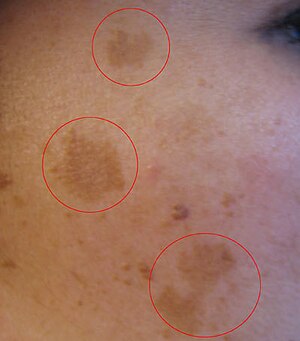Melasma
| Melasma | |
|---|---|
 |
|
| Classification and external resources | |
| Specialty | Dermatology |
| ICD-10 | L81.1 |
| ICD-9-CM | 709.09 |
| DiseasesDB | 2402 |
| MedlinePlus | 000836 |
| eMedicine | derm/260 |
| Patient UK | Melasma |
| MeSH | D008548 |
Melasma (also known as chloasma faciei, or the mask of pregnancy when present in pregnant women) is a tan or dark skin discoloration. Although it can affect anyone, melasma is particularly common in women, especially pregnant women and those who are taking oral or patch contraceptives or hormone replacement therapy (HRT) medications.
The symptoms of melasma are dark, irregular well demarcated hyperpigmented macules to patches commonly found on the upper cheek, nose, lips, upper lip, and forehead. These patches often develop gradually over time. Melasma does not cause any other symptoms beyond the cosmetic discoloration. Melasma is also common in pre-menopausal women. It is thought to be enhanced by surges in certain hormones.
Melasma is thought to be the stimulation of melanocytes (cells in the epidermal layer of skin that produce a pigment called melanin) by the female sex hormones estrogen and progesterone to produce more melanin pigments when the skin is exposed to sun. Women with a light brown skin type who are living in regions with intense sun exposure are particularly susceptible to developing this condition.
Genetic predisposition is also a major factor in determining whether someone will develop melasma.
The incidence of melasma also increases in patients with thyroid disease. It is thought that the overproduction of melanocyte-stimulating hormone (MSH) brought on by stress can cause outbreaks of this condition. Other rare causes of melasma include allergic reaction to medications and cosmetics.
Melasma Suprarenale (Latin - above the kidneys) is a symptom of Addison's disease, particularly when caused by pressure or minor injury to the skin, as discovered by Dr. FJJ Schmidt of Rotterdam in 1859.
Melasma is usually diagnosed visually or with assistance of a Wood's lamp (340 - 400 nm wavelength). Under Wood's lamp, excess melanin in the epidermis can be distinguished from that of the dermis.
...
Wikipedia
